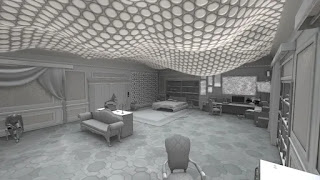White Rooms & Clothes
Analysis of Secondary Themes Associated with: White Rooms
Following a deep-dive research phase compiling instances and contexts related to 'White Rooms ' across a wide range of pop culture mediums (including film, television, games, literature, comics, art, and more), an analysis of the gathered pool revealed the following recurring secondary themes, associated patterns, interpretations, and commonalities frequently appearing in connection with the primary topic (prioritizing themes related to extraordinary elements first, followed by themes of spiritual wisdom/philosophy, and then other themes where applicable):
- Representing Non-Physical Spaces (Mental Constructs, VR, Loading Zones): White rooms frequently function as representations of spaces outside physical reality, such as virtual reality loading areas, mental training constructs (The Matrix), dreamscapes, subconscious realms, or digital spaces where reality can be manipulated or created.
- Spaces Outside Normal Time/Space or Dimensional Thresholds: They often depict locations existing beyond conventional spacetime, serving as transitional zones, pocket dimensions, gateways between realities, limbo states (Inception), or places where the laws of physics may not apply normally (2001: A Space Odyssey final sequence).
- Sites of Creation, Manifestation, or Pure Potential: The blankness of a white room can symbolize a void or canvas from which anything can be created or manifested, representing pure potential, the beginning of existence, or a space where thoughts shape reality.
- (Less Common) Depicting Heaven, the Afterlife, or Divine Realms: Sometimes, white rooms are used to portray celestial realms, heaven, or encounter spaces with divine/ascended beings, emphasizing purity, light, and transcendence from the physical world.
- Settings for Advanced Scientific/Psychological Experimentation or Testing: White rooms often serve as sterile environments for scientific or psychological experiments, testing chambers (Portal), observation rooms, or containment areas, sometimes involving advanced technology or morally questionable procedures.
- Symbolizing Clarity, Truth, or Stripping Away Illusions: The starkness and lack of distraction can represent a space where truth is revealed, illusions are stripped away, and characters confront fundamental realities or expose hidden motives, providing stark clarity.
- Representing Emptiness, the Void, or Nihilism: Conversely, the featurelessness can symbolize emptiness, isolation, meaninglessness, the void, or a nihilistic state devoid of substance or connection.
- Signifying a Blank Slate, Rebirth, or Beginning: A white room can represent a starting point, a chance for rebirth, wiping the slate clean, or the potential for new beginnings free from past constraints.
- Exploring Themes of Consciousness, Mind, and Perception: These spaces often serve as metaphorical arenas for exploring the nature of consciousness, the mind's construction of reality, subjectivity, and the limits or potential of perception.
- Inducing Feelings of Isolation, Confinement, or Sensory Deprivation: The lack of features, color, and often defined boundaries can create intense feelings of isolation, imprisonment, sensory deprivation, disorientation, and psychological distress.
- Associated with Mental Instability, Sanity/Insanity, or Loss of Identity: White rooms strongly evoke imagery of psychiatric institutions (padded cells, sterile environments), often used to symbolize mental breakdown, the fragility of sanity, depersonalization, or the loss of individual identity.
- Representing Sterility, Clinical Coldness, or Lack of Emotion: The white aesthetic frequently conveys a sense of clinical detachment, sterility, lack of warmth or emotion, precision, and sometimes dehumanization.
- Functioning as Interrogation or Control Environments: Stark white rooms are sometimes used as settings for interrogation, implying psychological pressure, control, lack of escape, and the stripping away of defenses.
- Modernist Aesthetic: In design contexts, white rooms simply represent a minimalist, modern aesthetic emphasizing light, space, and cleanliness.
DC Comics
The Matrix
Mobil_Avenue (Train)
Harry Potter
Assassins Creed
Hunger Games
Deus Ex-Human Revolution
Dragon Ball:
A)
https://dragonball.fandom.com/wiki/Hyperbolic_Time_Chamber
"Room of Spirit and Time") is a mysterious dimension that exists outside of Universe 7 but can be accessed from the universe via different doorways. Each chamber has a time-compressed nature, making the flow of time vastly different compared to the flow of time outside of the chamber."
B)
dragonball.fandom.com/wiki/Sir_Warp
https://www.youtube.com/watch?v=7HrFu_V7u6k&ab_channel=Goku.
Enslaved:
enslaved.fandom.com/wiki/Pyramid_(Character)
Marvel-1:
Appearing first in these comics in the early 90s here and here:
https://marvel.fandom.com/wiki/Quasar_Vol_1_42
https://marvel.fandom.com/wiki/Quasar_Vol_1_43
and later in the mid 90s here:
https://marvel.fandom.com/wiki/Guardians_of_the_Galaxy_Vol_1_61
White_Room_(Protectors_of_the_Universe)
https://maplurker.blogspot.com/2024/11/marvel-eon-white-room.html
These 3 are also great examples:
Marvel-2
Generator Rex
You-Zitsu
https://villains.fandom.com/wiki/White_Room
https://you-zitsu.fandom.com/wiki/White_Room














_from_Quasar_Vol_1_42_0001.webp)






Comments
Post a Comment